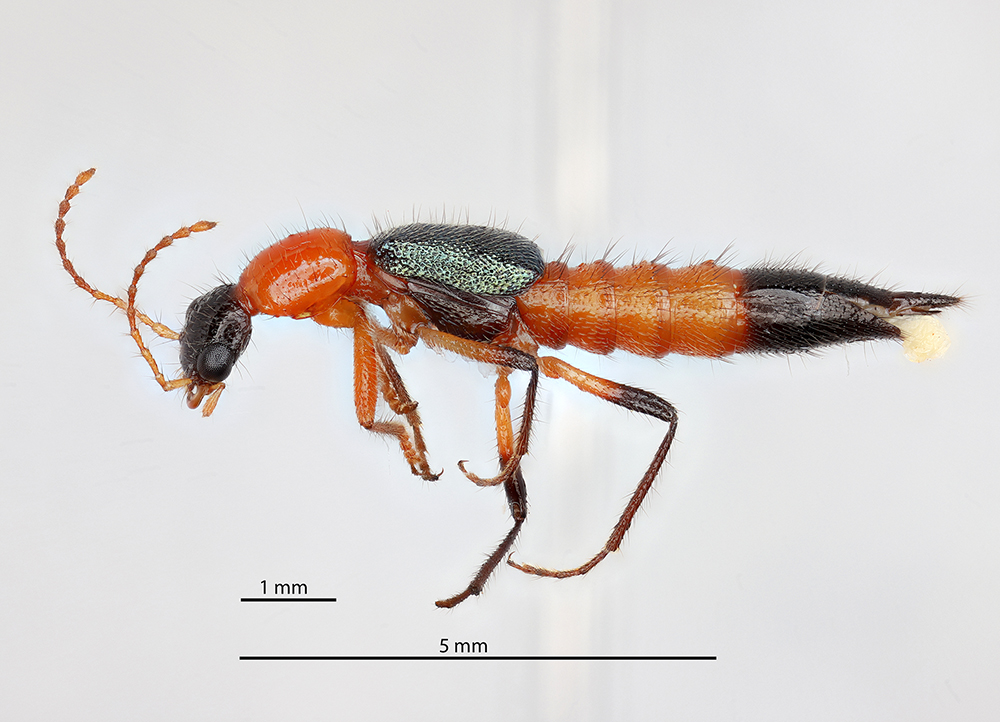Paederus sp. (Coleoptera: Staphylinidae: Paederinae: Paederini)
This week we bow to the wishes of Thomas Dubois who would like to see less of the tiny wasps and more of the beetles in the Insect of the Week. Here, we focus our attention on the much-maligned rove beetle genus Paederus, a member of the family Staphylinidae. Paederus is a large genus with over 475 species. In contrast to most rove beetles Paederus species are often richly clothed in patterns of orange and metallic blue, green and black. These colours, while pleasing to the human eye, are thought to have an aposematic (warning) function, with potential predators learning not to attack Paederus, or face the consequences for doing so.
Many Paederus species contain the blister-producing toxin, pederin. Paederus sabaeus was the primary cause of an epidemic of Paederus dermatitis in Kenya during the impressive El Niño rainfall season of 1997-98. One study determined that fully 1/3 of the Nairobi population reported having blistering vesicles during those El Niño rains. The blistering is a painful condition resulting from the contact of beetle fluids with human skin. A typical event would look like this; (1) Paederus lands on human, (2) human becomes irritated by creepy-crawly and brushes against, or crushes, the beetle (3) Paederus releases pederin, the immediate cause of the dermatitis. Pederin is a fascinating compound and is the most complex (molecular formula C25H45NO9) nonproteinaceous insect secretion known. Although found in the hemolymph (blood) of the beetle, the compound itself is produced by an endosymbiotic gram-negative bacterium, Pseudomonus sp. It is extremely toxic, with an LD50 greater than that of cobra venom. But fear not, it may be a nasty compound but in the very small amount contained in a small beetle, it is of no great concern to humans as a poison or a vesicant. It is a transient condition that resolves itself in about two weeks. It is a bit painful however and should not be underestimated as a source of discomfort. Some of the more fanciful local names for Paederus dermatitis attest to this. It is known as “spider lick”, “night burn” and “whiplash dermatitis”! In Kenya the beetle is called “Nairobi fly” (but not by the knowledgeable – since it isn’t a fly at all) and “Nairobi eye” if the toxin is located near to or in the eye.
The population size of Paederus depends on rainfall. The primary habitat of Paederus larvae is moist grass and herbaceous plants. Both adults and larvae are predaceous. Although small numbers of adults will usually be found in times of normal rainfall, exceptional rainfall events such as those of El Niño can lead to explosive population increases. Adults are diurnal (day active) but are also attracted to light, both traits favouring interactions with humans. If Paederus populations do become very high, close doors and windows at night, and close curtains as well.
Speaking of fanciful, The Lancet, among the most important medical journals in the world, published an interesting article suggesting that several of the biblical plagues (!) could be directly or indirectly connected with large increases in populations of Paederus species. Turning water to blood (plague 1) may have been an outbreak of red tide (Harmful algal blooms), associated with die-offs in the frog and fish populations due to lowered oxygen levels. The frogs (plague 2) leave the water and die, and the fish die in it or at the margins. The dead frogs and fish serve to increase the population size of Paederus species whose larvae will feed facultatively on the vertebrate remains. Plagues 3 and 4 would both refer to the explosive growth of Paederus alfierii (the Paederus species of the Nile delta). In my opinion, the connection between plague 3 (lice) and Paederus seems a stretch since lice cannot fly. Nonetheless, to carry on, Plague 6 (boils) would be the result of the high likelihood of interactions between humans and Paederus.
Paederus is not all bad news. Incredibly, pederin has been synthesized in the laboratory and in trials has been shown to reduce tumor size in mice. Perhaps someday it will be of use in cancer treatments.

Credits: Dr Robert Copeland

